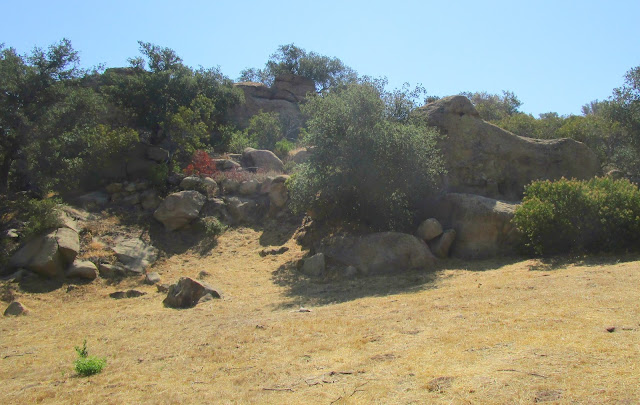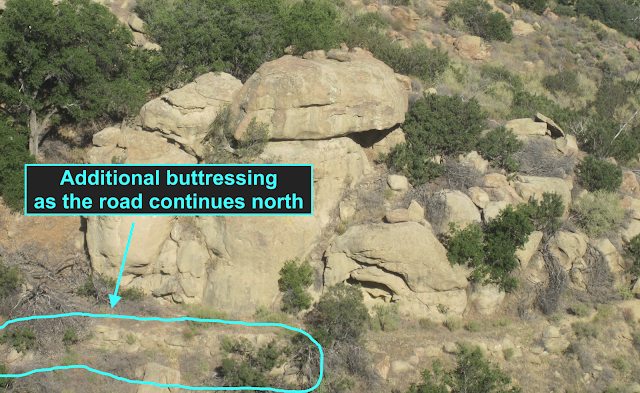Old movie road on the Upper Iverson — bottom left corner
Iverson explorer Cliff Roberts tipped me off recently that he spotted what appeared to be an old abandoned movie road during a visit to the former Upper Iverson Movie Ranch.
A row of stone buttressing, now largely hidden in dry grass, marks the base of the road, which works its way south up Cactus Hill — toward the right in this photo.
The road is mostly overgrown now, but much of the buttressing remains intact.
The road is located on the Upper Iverson's Southwest Rim and extends up Cactus Hill from the hill's north side.
The buttressing is impressive, continuing up the hill along the northwest edge of the road. The road has been documented previously, but has remained relatively obscure. This was my first time exploring it.
This recent Google aerial shows approximately where the stone buttressing is located. The buttressed section of road runs along the foot of a large rock feature widely known as Prominent Rock.
Comparing the recent aerial view with a shot of the same area from 1952, we can see that the movie road had a substantial footprint back in the filming era. (The next photo pinpoints the footprint.)
This version of the 1952 aerial delineates the route followed by the movie road. The southern end of the road connected with the main network of roads traversing the top of Cactus Hill.
The "footprint" seen in 1952 no longer exists. The main road has been widened to provide access to the water tanks, and other smaller roads also remain in place, but the buttressed movie road has been overtaken by foliage.
Back at ground level, Cliff walks ahead on the road, heading southwest
While we're not the first location enthusiasts to find our way to the road, it has been lying dormant in recent years and remains one of the Upper Iverson's well-kept secrets.
The buttressing area is sheltered by trees and remains green, even after years of drought. The terrain around the road is quite scenic in spots, but poison oak is rampant in the area.
Here's another shot of the buttressing, this time looking northeast toward the base of the road. The road was first noted by location researcher Tinsley E. Yarbrough in "Those Great Western Movie Locations," published in 2008.
The road rises as it works its way south; this shot from ground level includes an elevated section of buttressing in the left half of the frame. As it continues south, the road passes behind the bulbous rock feature on the right.
The buttressing is identified here, along with the bulbous rock, which some readers may recognize from the backgrounds of Western chase sequences. I call the rock "Bignose," for lack of a better word.
This unusual "character," which is part of the buttressing, reminds me of a toadstool. As the buttressing is manmade, I can't help wondering whether somebody realized what they were creating when they set this up.
Farther up the hill, the road becomes virtually impassable.
The rugged area near the top of the road is dominated by sagebrush and other vegetation, punctuated by dynamic sandstone formations.
I inadvertently spooked a mother bird in her nest as I tromped past, leaving me face to face with her frightened chicks after the mom flew the coop. The area doesn't get much foot traffic.
"Lawless Cowboys" (1951): Whip Wilson on the buttressed road
The most extensive filming on the old road appears to have taken place near the base of the road — the buttressed section — as in this example from the Monogram B-Western "Lawless Cowboys."
I've identified a couple of rock features here that can also be seen in the Whip Wilson screen shot.
Here's the "Lawless Cowboys" shot again, with rocks "A" and "B" noted.
This shot provides a closer look at rock "B." The sharp angle at the top of it makes it readily identifiable.
Notice the tree identified here, which is located next to rock B.
The tree is gone now, but its stump remains.
"Lawless Cowboys": Whip Wilson rides northeast from the buttressed road
A wide shot from "Lawless Cowboys" shows the area on the Upper Iverson's Southwest Rim where the north end of the buttressed road empties out onto the flatland.
A number of features can be identified in the "Lawless Cowboys" shot. Some of these features will be familiar to veteran Iverson Movie Ranch watchers.
Notice the rock feature highlighted here. This small rock wall is positioned near the base of the buttressed road.
The small rock wall remains in place today, as seen in this photo from our recent visit.
I tried to get a shot capturing the juxtaposition of Round Rock and the small rock wall, similar to the "Lawless Cowboys" shot, but the tree near Round Rock has grown so big that it blocks the view of the rock from this angle.
"Leadville Gunslinger" (Allan "Rocky" Lane, 1952)
Tinsley Yarbrough notes in "Those Great Western Movie Locations" that Rocky Lane traveled the road in "Leadville Gunslinger." The above shot from the movie was filmed about halfway up the road.
One of the rocks situated right next to the movie road is Shadow Rock. While it may seem like a bit player in this shot, it's usually seen from other angles and is a significant movie rock in its own right.
You may have already noticed that Shadow Rock is almost hidden in darkness. That's virtually always the case with Shadow Rock, which is why I started calling it that.
A similar shot can be found in the Johnny Mack Brown movie "Rawhide Rangers." In this case the shadows haven't quite reached Shadow Rock yet, but even so, the front end of the rock isn't exactly lit up.
A more typical appearance for Shadow Rock is this one in the Republic serial "The Tiger Woman."
There's Shadow Rock yet again, directly above the horses in the Monte Hale Western "California Firebrand." The rock appears in color this time, but there's that shadow again — some things never change.
Since the old movie road goes right past Shadow Rock — and since it seems like a good name for an old movie road — I started calling it "Shadow Rock Road."
"Leadville Gunslinger": Shadow Rock Road and the view to the north
Besides filming the Shadow Rock end of the road, the "Leadville Gunslinger" crew turned the camera in the other direction. With the camera now facing north, we see a part of the road with a view of the Upper Iverson.
"Gold Raiders" (Three Stooges, 1951)
The buttressing near the bottom section of the road can be spotted occasionally in backgrounds, as in the Three Stooges movie "Gold Raiders."
The "Gold Raiders" shot illustrates the road's position between Prominent Rock and the small rock wall.
"Adventures of Spin and Marty" (1955): Stone buttressing on the Lower Iverson
Stone buttressing has survived in a number of locations on the former Iverson Ranch. The best-known example is found along the "Steep Canyon Road" that runs through the Gorge below Nyoka Cliff.
Promo still for "Pack Train" (1953) — photo from the Jerry England collection
A classic shot of this buttressing on the Lower Iverson appears in a promotional still for the Gene Autry movie "Pack Train." This is essentially the same section seen in the shot from "Spin and Marty."
Lower Nyoka Cliff and the Steep Canyon Road in 2014
The buttressing seen in "Spin and Marty" and "Pack Train" has deteriorated significantly since the filming era, but remains somewhat intact.
This shot points out the portion of the stone buttressing that appears in the movie and TV shots above.
A number of other sections of the buttressing along the Steep Canyon Road have also survived.
An especially well-preserved section of buttressing is found higher up in the Gorge, below Lone Ranger Rock.
The Steep Canyon Road is also known as the stagecoach road, although that name has led to the mistaken belief that it was an actual stagecoach road, an issue I talked about in an earlier post that you can click here to read.
Above is a link to a nine-movie DVD set that includes "Lawless Cowboys" and a number of other cool Iverson movies in terrific picture quality, in case you might be into that sort of thing — mostly Whip Wilson and Johnny Mack Brown B-Westerns, along with a couple of non-Iverson Jimmy Wakely movies.









































































